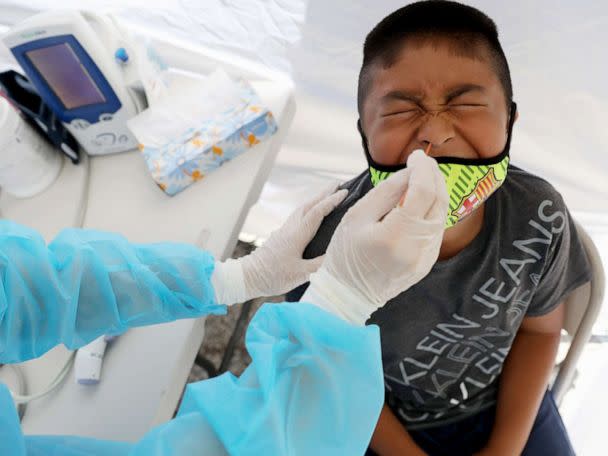In recent weeks, hospitals in Washington, DC, Los Angeles, Colorado, Nebraska and New Jersey have reported an increase in cases of MIS-C, a rare inflammatory disease found in children.
The apparent increase in MIS-C cases coincides with a decrease in COVID-19 cases across the country, following a post-holiday increase. But experts interviewed by ABC News explained that there is usually a gap – sometimes three to four weeks – between COVID-19 infections and the onset of MIS-C symptoms.
“MIS-C is a post-infectious complication of coronavirus infection, which manifests itself only about four weeks or more after a child has had his initial infection,” said Dr. Audrey John, a specialist in pediatric infectious diseases at the Children’s Hospital of Philadelphia.
Most children infected with COVID-19 are asymptomatic or have mild symptoms. Although MIS-C is rare, its effects can be devastating and fatal, with some patients experiencing inflammation of the heart, lungs, kidneys, brain, skin, eyes or gastrointestinal organs.

“The increase in MIS-C cases is probably due to the increase in the number of COVID-19 infections, ultimately due to the recent outbreaks of holidays such as Thanksgiving, Christmas, New Year and Super Bowl,” said the Dr. Todd Ellerin, ABC News collaborator and infectious disease specialist at South Shore Health.
Infectious disease experts said there is no evidence that new variants of COVID-19 are more likely to cause MIS-C, and the most likely explanation for the increase in cases is the increase in general COVID cases during the peak. recent.
MORE: Variants of COVID Discovered in the USA Reveal Clues to the Evolution of the Virus
According to the Centers for Disease Control and Prevention, at least 2.8 million cases of COVID-19 in the United States were in children. There were about 2,060 cases of MIS-C, to which 30 deaths were attributed.
Although the CDC has stated that data for the past six weeks is not complete, hospitals are reporting a dramatic increase in cases – LA County has reported a 35% increase in children with MIS-C in the past two weeks.

“MIS-C can show up to 12 weeks after acute COVID-19 infection, even if asymptomatic, so we are probably in the middle of the MIS-C wave,” said Dr. Michael Chang, a specialist in pediatric infectious diseases at McGovern College of UTHealth Medicine in Houston.
Children with MIS-C may develop symptoms including fever, palpitations, rapid breathing, abdominal pain, vomiting, diarrhea, fatigue, headache, enlarged lymph nodes or redness and / or swelling of the eyes, lips, tongue, hands or feet. This makes diagnosing MIS-C cases much more challenging as it mimics many common pediatric diseases.
MORE: the number of COVID-19 cases has dropped, signaling that the winter peak is decreasing
Mirroring racial disparities with COVID-19 infections, MIS-C is seen most frequently among black and Latino children, however, there is still a lot of work to determine how race, ethnicity and underlying socioeconomic status influence trends in MIS-C cases. across the pediatric population. Fortunately, most children with MIS-C respond well to IV fluids, antibiotics, steroids and / or IVIG therapy and recover fully.
Although experts still do not understand exactly why some children develop MIS-C and others do not, more cases of COVID-19 among children probably also mean more cases of MIS-C. That’s why health experts and pediatricians are pushing for vaccines for children, not just for people 16 and older covered by current vaccines.
“Children are our most precious resource,” said Dr. Tina Cheng, head of the Pediatric Department at Children’s Hospital in Cincinnati. “They represent less than 10% of US healthcare spending, but they are 100% of our future.”
Raehannah Jamshidi, MD, Ph.D., a pediatric resident at McGovern Medical School at UTHealth in Houston, is a contributor to ABC News Medical Unit.
The holiday’s COVID-19 peak is to blame for the increase in cases of inflammatory syndrome in children in some US cities. Originally appeared on abcnews.go.com
